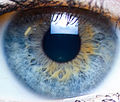Tyndall effect
Tyndall Effect
The Tyndall effect, also known as Tyndall scattering, is the scattering of light by particles in a colloid or in very fine suspensions. It is named after the 19th-century scientist John Tyndall, who first studied the phenomenon.
Explanation
The Tyndall effect occurs when light passes through a medium containing small particles that are large enough to scatter light, but not large enough to settle out of the solution. This scattering causes the path of the light to become visible. The intensity of the scattered light depends on the frequency of the light and the density of the particles.
The effect is more pronounced when the light is blue, which is why the sky appears blue. This is because blue light is scattered more than red light due to its shorter wavelength.
Examples
In Nature
The Tyndall effect is responsible for the blue color of the sky. As sunlight passes through the atmosphere, the shorter blue wavelengths are scattered in all directions by the gases and particles in the air. This scattered blue light is what we see when we look up at the sky.
Another example is the blue appearance of some eyes. The structure of the iris scatters light in a way that enhances the blue wavelengths, making the eyes appear blue.
In Everyday Life
The Tyndall effect can be observed in many everyday situations. For example, when a beam of sunlight enters a dusty room, the path of the light becomes visible due to the scattering of light by the dust particles.
In fog, the Tyndall effect can be seen when car headlights illuminate the tiny water droplets, making the beam of light visible.
Applications
The Tyndall effect is used in various scientific and industrial applications. It is used to determine the size and density of particles in a colloid. It is also used in laser technology and in the study of aerosols.
Related pages
References
- Tyndall, John. On the Blue Colour of the Sky, the Polarization of Skylight, and on the Polarization of Light by Cloudy Matter Generally. Proceedings of the Royal Society of London, 1869.
- Bohren, Craig F., and Donald R. Huffman. Absorption and Scattering of Light by Small Particles. Wiley, 1983.
Transform your life with W8MD's budget GLP-1 injections from $125.
W8MD offers a medical weight loss program to lose weight in Philadelphia. Our physician-supervised medical weight loss provides:
- Most insurances accepted or discounted self-pay rates. We will obtain insurance prior authorizations if needed.
- Generic GLP1 weight loss injections from $125 for the starting dose.
- Also offer prescription weight loss medications including Phentermine, Qsymia, Diethylpropion, Contrave etc.
NYC weight loss doctor appointments
Start your NYC weight loss journey today at our NYC medical weight loss and Philadelphia medical weight loss clinics.
- Call 718-946-5500 to lose weight in NYC or for medical weight loss in Philadelphia 215-676-2334.
- Tags:NYC medical weight loss, Philadelphia lose weight Zepbound NYC, Budget GLP1 weight loss injections, Wegovy Philadelphia, Wegovy NYC, Philadelphia medical weight loss, Brookly weight loss and Wegovy NYC
|
WikiMD's Wellness Encyclopedia |
| Let Food Be Thy Medicine Medicine Thy Food - Hippocrates |
Medical Disclaimer: WikiMD is not a substitute for professional medical advice. The information on WikiMD is provided as an information resource only, may be incorrect, outdated or misleading, and is not to be used or relied on for any diagnostic or treatment purposes. Please consult your health care provider before making any healthcare decisions or for guidance about a specific medical condition. WikiMD expressly disclaims responsibility, and shall have no liability, for any damages, loss, injury, or liability whatsoever suffered as a result of your reliance on the information contained in this site. By visiting this site you agree to the foregoing terms and conditions, which may from time to time be changed or supplemented by WikiMD. If you do not agree to the foregoing terms and conditions, you should not enter or use this site. See full disclaimer.
Credits:Most images are courtesy of Wikimedia commons, and templates, categories Wikipedia, licensed under CC BY SA or similar.
Contributors: Prab R. Tumpati, MD













